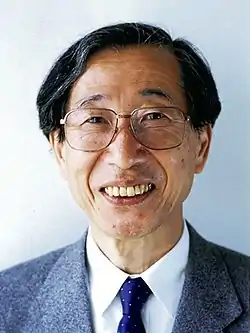Shun'ichi Amari
Shun'ichi Amari (甘利 俊一, Amari Shun'ichi), is a Japanese scholar born in 1936 in Tokyo, Japan.
Shun'ichi Amari | |
|---|---|
甘利 俊一 | |
 Shun'ichi Amari | |
| Born | 1936 (age 86–87) |
| Nationality | Japanese |
| Alma mater | University of Tokyo |
| Known for | Information Geometry Amari distance |
| Awards | IEEE Emanuel R. Piore Award (1997) |
Overviews
He majored in Mathematical Engineering in 1958 from the University of Tokyo then graduated in 1963 from the Graduate School of the University of Tokyo.
His M. Eng. in 1960 was entitled Topological and Information-Theoretical Foundation of Diakoptics and Codiakoptics. His Dr. Eng. in 1963 was entitled Diakoptics of Information Spaces.
Shun'ichi Amari received several awards and is a visiting professor of prestigious universities.
He is the author of more than 200 peer-reviewed articles[1] and is best known for inventing a way for the recurrent neural network to learn based on the Ising model from quantum physics, which is now imprecisely known as Hopfield network.
He is currently holding a position of the prestigious RIKEN lab and is vice-president of Brain Science Institute, director of Brain Style Information Systems Group and team leader of Mathematical Neuroscience Laboratory.[2]
He was a winner of the IEEE Emanuel R. Piore Award (1997)[3]
Concepts developed
Key works
- A Geometrical Theory of Information (in Japanese), Kyoritsu, 1968
- Information Theory (in Japanese), Daiamondo-sha, 1971
- Mathematical Theory of Nerve Nets (in Japanese), Sangyotosho, 1978
- Methods of Information Geometry,[4] in collaboration with Hiroshi Nagaoka, originally published in Japanese in 1993 and published in English in 2000 with the American Mathematical Society (AMS).
Awards and honors
- Japan Academy Prize (1995)
- IEEE Emanuel R. Piore Award (1997)
- C&C Prize (2003)
- Person of Cultural Merit (2012)
- Order of Culture (2019)
References
- Amari Shun'ichi's publication page at RIKEN Brain Science Institute
- Amari Shun'ichi's curriculum page at RIKEN Brain Science Institute
- "IEEE Emanuel R. Piore Award Recipients" (PDF). IEEE. Archived from the original (PDF) on November 24, 2010. Retrieved December 30, 2010.
- Methods of Information Geometry, Oxford University Press 2000
External links
- Homepage at Riken lab
- Information Geometry and Its Applications presented during ETVC´08 - Paris in November 2008
- Unconventional Computation 2010 (UC10) at Toky, invited speaker
- ResearchMap profile